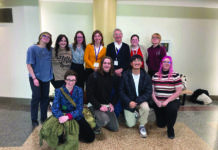“I’m here for the students,” Benjamin Pilat said. “I want to help them be as successful as possible, and I’m hoping to be a good resource for the students.”
Pilat is a professional lighting designer that has joined the Colorado Mesa University theater arts department for the spring semester. At CMU, he is teaching three classes and designing three shows.
“I had been teaching at Pepperdine University in Malibu prior to this,” Pilat said. “I left to pursue some of my own professional career. Less theater stuff and more art, combining light and art. I heard from a friend of a friend that there was an opening here and it just fit perfectly in my schedule to come out here for the spring semester and teach a few classes, design a few shows, and be a guest here before I go back to LA.”
He spent five to six years working for the Los Angeles Ballet. Pilat was their lighting designer.

“Part of my job there was creating new designs so I also implemented and maintained existing designs that other people created, but I got to add my own designs to the Los Angeles Ballet repertoire,” Pilat said.
He worked on several shows for that company including a large production of Swan Lake. Pilat explained that one of his favorite projects at that company was when contemporary choreographers came and staged modern dance on the classically trained ballerinas.
“It was this really cool fusion between modern dance and classical ballet and it was exciting and gave me an opportunity to really define the environment with light,” Pilat said. “And in dance more than in plays and musicals, in dance lighting, you can really define the environment. There aren’t any words so it opens up more creative possibility. You can create, I really love creating spaces with light, and dance offers one of the best opportunities to do that.”
Pilat will be the lighting designer for Thoroughly Modern Millie. He will be both the scenic and lighting designer for Mr. Burns. And will be the lighting designer for Spring into Dance.
“I’m really excited for Mr. Burns especially because I get to design the set and the lighting which is new for me. I get to design a set that works with lighting and visa versa,” Pilat said.
One of his three classes is called stage management. Along with learning stage management skills, Pilat has an extra curriculum that he believes is important to know for the future.
“In my stage management class we talk about things that don’t get talked about enough in college classes,” Pilat said. “Things like contracts, taxes, unions and budgets. And al those really important life things that don’t get covered really anywhere else. I put them in my stage management class because stage managers need to be leaders. They need to be people who have put on their own oxygen mask before they can help someone else.”

“There aren’t a lot of classes in college where you get to learn about how health care insurance works, what is a DEDUCTIBLE, how do i find an apartment, how to pay my rent…”
“I don’t just want to teach what is in the syllabus,” Pilat said. “I want to give students the skills they need to go out and do it successfully.”
One important skill that Pilat wants to make sure students know that as technical theater professionals you’re never done. He explained how learning to learn and hot to be a perpetual learner is a really important thing to do.
“I spend so much time just trying to keep up with what is new,” Pilat said. “It is a really interesting time to be a lighting designer right now because technology is changing everything about my job so quickly. We are at a moment where there is this revolution in lighting that we haven’t really seen since lighting became a thing with Thomas Edison’s light bulb.”
Pilat keeps up with the changing times by going to conferences, meeting manufacturers, watching webinars and tutorials.
“I still have so much to learn,” Pilat said.

Pilat has a BA degree in theater, but realized that he enjoyed lighting and wanted to learn more about it. He then went to get his masters in lighting from Boston University. Out of college, he moved to New York City and spent five years working as a lighting designer while also assisting more established lighting designers.
“I was on what I hoped would eventually become the Broadway career path, but I eventually realized that that wasn’t my dream,” Pilat said. “I enjoyed teaching more than I enjoyed having a full-time professional career.”
He taught classes during grad school, worked with students at Chaminade University of Honlulu and then most recently at Pepperdine University. He has worked as a lighting designer for different places all over the states. He worked in Massachusetts, New Hampshire, Saint Lewis and many other states.
“I did the Magic Flute in Santa Barbra at the Music Academy of the West,” Pilat said. “That was a delightful experience, the crew took care of me, the director was fantastic. The show ended up looking really nice and everyone was really happy.”
Another favorite experience was doing the lighting for a Juilliard production.
“On the crazier end of the spectrum, I spent a summer in Saint Lewis working at the MUNY. They do, at the time I was working there, seven musicals in seven weeks with no days off,” Pilat said. “You get one dress rehearsal from one in the morning to five in the morning only two days before the show opens. It was an outdoor theater and the sun has to be down to see the lighting. Shows usually start at sunset and go into the night. There was one opportunity to see the lighting before the audience did.”
Long hours and stress are part of the lifestyle. Pilat thinks maintaining a work-life balance is difficult in this profession.
“The entertainment industry demands long hour, it often requires that you eat unhealthy food, not get enough sleep and to work in a high-stress profession. It is always push push push to meet the opening night deadline,” Pilat said. “I think it comes with the territory.”
As it can be demanding and things are always changing, Pilat explains that the best part of being a lighting designer is seeing the finished product come together.

“Sometimes you don’t think it can come together. You think there is not enough time or not enough money, but at the end of the day the show always opens and as designers we usually surprise ourselves and it is really rewarding to see that opening night, hear an audiences’ reaction, see those performers on stage and that you are supporting them the best way possible,” Pilat said.
After this semester teaching his career has many possibilities.
“There is probably more theater in my future and definitely more teaching,” Pilat said. “I’m working on writing a book on lighting and I eventually want to offer vocational classes to students who want to learn more about lighting without necessarily committing to a four-year degree. My career might eventually lead me to combining lighting and smart home or a gallery show of light art.”





